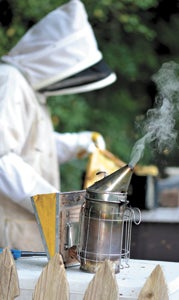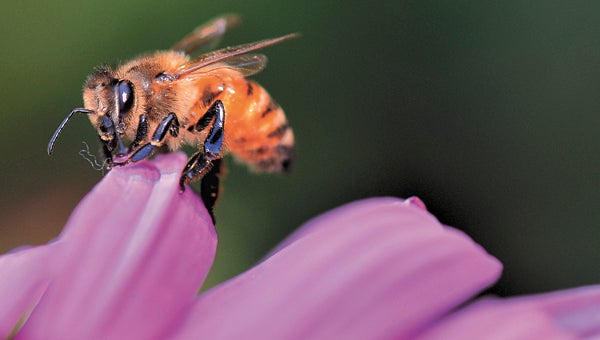Building a better bee
Published 10:45 pm Thursday, May 16, 2013
Everyone has a job in the hive, even the queen.
While the worker-bees go about tending the young, gathering food, producing energy sources for the winter and even evicting the corpses of dead workers, the queen bee is busy producing more workers.
These hives — actually, they’re white boxes filled with frames covered in bees — occupy a corner of the property around the home of Sean and Jan Kenny. Visitors can easily see the activity of bees coming and going even from a distance that makes a bulky beekeeping suit unnecessary.
But Sean Kenny isn’t satisfied with keeping a safe distance. Lately he has chosen to get up close and personal with his bees, all in pursuit of the perfect queen.
Sean and Jan Kenny are on the leading edge of honeybee eugenics.
The Chuckatuck-area residents received a grant from the Virginia Department of Agriculture and Consumer Services to help them breed a superior strain of bees that will be more resistant to diseases and parasites, especially the varroa mite.
The grant paid for equipment and training for Sean Kenny to learn how to artificially inseminate queen bees. It’s a process that takes place on a kitchen table, sans bee suit, under a powerful and expensive microscope.
The Kennys will obtain genetic material from lines of bees known to be more resistant to invaders, propagate those genetics among their more than 60 colonies and eventually create a better bee population in eastern Virginia.
The Kennys didn’t get into beekeeping thinking they would be inseminating bees only a few years down the road. It all started when they met a beekeeper at the Driver Days festival shortly after moving to Suffolk.
For Sean Kenny, it harkened back to a day when he was a kid, sitting on a porch with his brother. A swarm of bees landed on a pine tree right next to the porch, and the boys were intrigued.

Sean Kenny, in a bee suit, works in one of his 60 or so beehives with a smoker in the foreground. The smoke confuses the bees and calms them down while he works.
The event apparently had a profound effect on both boys. When Sean got his first hive and called his brother to tell him what he’d done, his brother’s incredulous first response was to turn to his wife and say, “What have I always wanted to do?” Her hesitant answer: “Be a beekeeper?”
The Kennys have become increasingly involved in beekeeping since that first hive. They are members of the Tidewater Beekeepers Association, and he has been a vice president of the organization. Today they have roughly 60 hives spread throughout the Chuckatuck area on their own property and on farmers’ acreage.
The farmers — and their neighbors — love the attention paid to their crops. Joseph and Shelly Barlow get pollination for their community-supported agriculture garden, which raises various produce throughout the year, and they likely get a higher yield on their cotton — which doesn’t require pollination, but it helps.
A neighbors’ apple tree never produced anything until the Kennys got their bees, and now the branches sag with the weight of the fruit. Another neighbor “is always coming over and bringing us blueberries and thanking us for having the bees,” Jan Kenny said.
“It’s a mutually beneficial arrangement,” Sean Kenny said.
But before they can create a better bee, the Kennys must first pollinate the bees themselves.
In late April, they received a shipment of eight queen bees from the U.S. Department of Agriculture, already inseminated with preferred lineage. Each bee is marked with a color-coded cap on her head — her crown, since she’s a queen — and the cap has a code written on it that will stay there for the rest of her life, allowing the USDA to trace her lineage.
Kenny puts the container with the queen into a queenless hive and lets the workers eat away at a sugar plug blocking them from their new queen. Once she is free, the queen — it is hoped — will begin laying eggs that will develop into better bees.
The Kennys will keep detailed records on how the new brood behaves and performs.
He also will inseminate some queens himself. The queen bee is anesthetized with carbon dioxide and held in place on a microscope with forceps. A syringe filled with bee semen is lowered, and the genetic material is inserted into her abdomen. The process is labor-intensive, but Kenny says his work as a NASA engineer is harder.
Throughout all of this, of course, they hope not to get stung. Honeybees don’t take kindly to people stealing their honey or messing about their hives. Considering the Kennys’ hives are home to more than a million bees, they have been stung remarkably few times. Sean Kenny is pretty used to it by now, but he hates the thought of getting stung on the face.
Even so, the Kennys harvest the honey three seasons out of the year, selling it at festivals, farmers’ markets, retail stores and sometimes straight from their back door. Some jars they save to sell the following year to allergy sufferers, who say eating the season’s raw honey cures their symptoms. Their honey is not pasteurized, because heating it negates its health benefits.
It is an expensive, time-consuming and surprisingly technical hobby, but the Kennys hope their work will soon result in a better bee in southeastern Virginia.
“We hope to have the area flooded with this kind of genetics,” Sean Kenny said.






